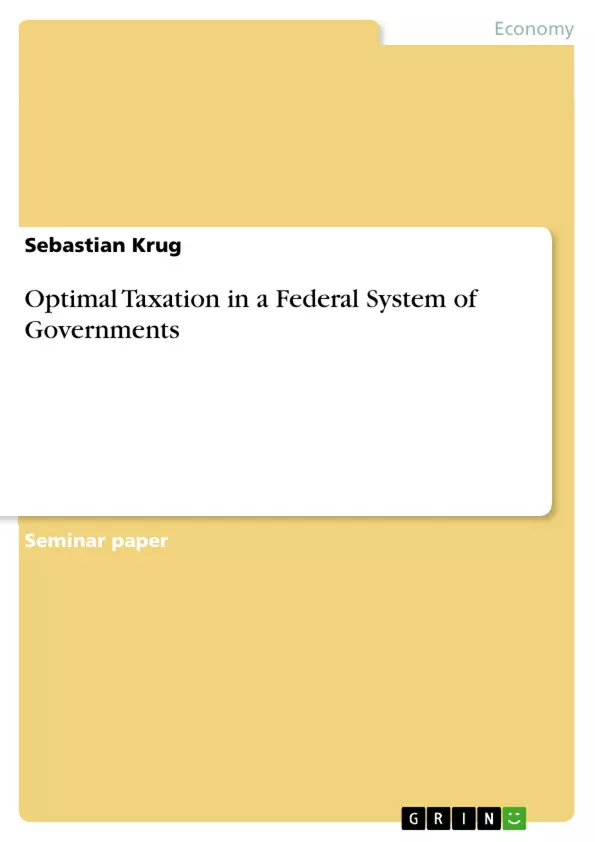An implemented tax system causes distortions which leads to a minor overall welfare level compared to a system without taxes. This deviation in social welfare is often denoted by excess burden or dead weight loss (DWL) of taxation. So the traditional optimal taxation approach comprises the implementation of a tax system which minimizes the excess burden and hence the distortions caused by the levied taxes. Therefore, the policy maker has to anticipate possible behavioral adjustments of the market participants when choosing its optimal tax policy. Assuming the policy maker will do so all effects (i.e. distortions) caused by the tax system will be internalized which means that no fiscal externalities would arise from implementing the (optimal) tax system. However, the traditional optimal taxation approach abstracts from any intergovernmental relations as the existence of only one government and accordingly only one level with fiscal jurisdiction is assumed. The question here is whether and to what extent federal structures (i.e. multileveled government structures) affect the optimal tax policy decision.
The first attempt to take into account the characteristics of a federal system
related to optimal tax policy goes back to Gordon (1983) who applied the methodology
of the traditional optimal taxation approach to fiscal federalism. Therein each
unit of government (i.e. the federal and usually several state governments) decides
independently how much of public goods to provide and in particular which tax
policy to use in funding the provided public goods. Hence, we now consider a decentralized
form of decision-making in which each unit of government chooses the
optimal tax policy in the best interest of its own residents. As a consequence of this
solely intrajurisdictional externalities are internalized analogous to the traditional
optimization approach. Though, it isn’t obvious whether this solution is also optimal
in the sense of an inter jurisdictional point of view. Sobel (1997), Wrede (1999)
and also Keen/Kotsogiannis (2002) stated that a common pool problem emerges
given that subordinated governments (i.e. state governments) are allowed to levy
taxes as well as the federal government. This means that taxation at multiple levels
lead to a shared tax base which is the fiscal analogue to the common property
resource. Due to this overlap in tax bases any separately considered optimal tax
policy at a certain level may affect the optimality character of the ...
Inhaltsverzeichnis (Table of Contents)
- Introduction
- Taxonomy of fiscal externalities
- Why vertical fiscal externalities tend to cause inefficiently high tax rates
- Development of an optimal tax policy to fiscal federalism
- How many levels of government should have the right to levy taxes?
- How should the optimal tax policy be designed?
- Which level of government should excise taxes?
- Concluding Remarks
Zielsetzung und Themenschwerpunkte (Objectives and Key Themes)
This paper analyzes the optimal design of tax policy within a federal system of governments, focusing on the challenges posed by vertical fiscal externalities.
- The paper explores the taxonomy of fiscal externalities, highlighting their potential to cause inefficiently high tax rates.
- It examines the implications of different levels of government having the right to levy taxes and the design of optimal tax policies.
- The paper delves into the question of which level of government should implement excise taxes in a federal system.
- It investigates how vertical fiscal externalities can lead to a suboptimal allocation of resources.
- The study aims to provide insights into designing efficient tax policies in a federal context.
Zusammenfassung der Kapitel (Chapter Summaries)
- Introduction: This chapter provides an overview of the topic and sets the stage for the subsequent analysis. It outlines the challenges of designing efficient tax policies in a federal system, particularly those related to vertical fiscal externalities.
- Taxonomy of fiscal externalities: This chapter defines and classifies different types of fiscal externalities, focusing on the impact of these externalities on tax policy decisions.
- Why vertical fiscal externalities tend to cause inefficiently high tax rates: This chapter analyzes the mechanisms by which vertical fiscal externalities can lead to inefficiently high tax rates. It examines the implications of overlapping tax bases and the resulting distortions in resource allocation.
- Development of an optimal tax policy to fiscal federalism: This chapter explores the key questions surrounding the design of an optimal tax policy in a federal system. It considers issues such as the appropriate number of government levels, the optimal tax structure, and the allocation of excise tax responsibilities.
Schlüsselwörter (Keywords)
The primary keywords and focus topics include fiscal federalism, vertical fiscal externalities, optimal tax policy, tax base overlap, inefficient tax rates, excise taxes, and resource allocation.
- Quote paper
- Dipl.-Kfm. Sebastian Krug (Author), 2011, Optimal Taxation in a Federal System of Governments, Munich, GRIN Verlag, https://www.grin.com/document/165499



